#cognition
Explore tagged Tumblr posts
Text
When you picture yourself in your mind, do you imagine yourself precisely how you look in real life, or do you see something else (an alter ego, a person who looks differently, another being, etc.)? When you're visualizing from the first person's pov, whose hands are you seeing? If you have aphantasia, consider "seeing" as a metaphor for the way you think of the concept of yourself.
The main options (we put them here due to the character limit):
🪞: I only imagine myself the way I look like irl.
🪆: I imagine someone/something that represents me.
✨️: I imagine myself in multiple ways: the way I am, as another being, as an abstract concept, you name it.
Please reblog for a bigger sample size and feel free to expand on your answer in the comments / tags!
Credit to @anon (we added a few options).
#minds eye#imagination#self concept#lgbtqia#aphantasia#psychology#cognition#queer#nonbinary#agender#transgender#did system#dissociation#depersonalisation and derealisation#neurodiversity#spirituality#tumblr polls#tumbler polls
4K notes
·
View notes
Text

William J. Mitchell, The Logic of Architecture Design, Computation and Cognition, A Vocabulary of Stair Motifs (After Thiis Evensen, 1988)
#William J. Mitchell#stair#architecture#design#art#vocabulary#a vocabulary of stair motifs#the logic of architecture design#computation#cognition
739 notes
·
View notes
Text


sometimes you just gotta make your tief sit the heck down
136 notes
·
View notes
Text


A polynon is a conceptual geometric entity of which vertices are non-events and its edges holograms.
A polynon contains all the holograms of that which can be projected as a polytope, showing how consciousness can be fundamental.
In the Hexanon, shown above, the Observer O(n) is in superposition with the phenomenal p+, epiphenomenal p-, negative noumena n- and noumenal vertices n+ of the hexanon as a function for self-reflection of consciousness C.
The polynon is built on the lens mechanism of the wavefunction: each layer of the noumenal lens is a wavefunction in itself, providing mechanism for the observer as function of noumenal reflection.
The paper is now available on philpapers, as well: https://philarchive.org/rec/ROITPA
54 notes
·
View notes
Text
Your ability to describe the world affects how you think about it. If the language and idioms you know are constrained to a particular window, that window will act as a constraint in shaping not only how you see the world, but also how you experience the world.
156 notes
·
View notes
Text
Theory
Haven't finished Persona 5 Royal, but, grrr-the idea of Akechi as a cognition? Incredible.
He's not real, he's never been real to you, not to anyone probably. He's honest in the boiler room, tells you he hates you. He won't let you take him home. He kills himself-not like that, not ever like that. Too pedestrian, probably.
There has to be some part of him that liked you. You could tell he wanted to come home-but he died. Died and was gone, and you couldn't save him.
It's your dearest wish, to bring him back, for love, for his unrealized potential, for being the one person you couldn't save-give or take a few, but they don't matter. He's not happy in this world. He can't ever be happy. He was a tool, and he can't stand being a tool again. (That part sticks with you. You don't like remembering the things he said about you, about being alone.) Your team fights side-by-side with him, and it works, and nothing goes wrong. And it's the day before the infiltration, and Maruki comes to you, and says that Akechi's fake. Not like that, he's too tactful, but he wasn't real the whole time. Maybe you knew that, but you don't think so.
Akechi's a doll-made from your wishes-Maruki did it for you, maybe he took some things from your friends, maybe from his landlord-you're sure he didn't put anything from Shido (are you sure? Shido's known Akechi so much longer than you have-) It explains why his mother's not here. He's a puppet. Puppets don't get their own families, not just from wanting it. The only reason he's not happy is because you can't imagine him that way, not in a world like this. And you needed to save Sumire, but you couldn't have done it without Akechi. He was there to support you-he was your desires given flesh. Awfully unlucky of Maruki, huh? Your greatest desire was still to rebel, even when he had a face of his own. You couldn't leave reality the way it was, couldn't let Maruki destroy himself-the reasons spiral aroudn in your head again and again. But Akechi was the thing that made it possible, and he wasn't real.
Maybe it's your fault he couldn't be happy like this. Maybe if you listened to what he said in the engine room-you noticed he was different, but it's not like you ever knew him in the first place. Maybe if you'd held onto what he wanted from you-beneath him, groveling at his feet, maybe he would've been happy.
And it'd be wrong, but he'd be more than what you needed him to be. But he's dead, and you've never known him, not really, and you loved him and you can't get him back
I don't want Akechi alive. I want reality to bend around you. (I see so very many people write him as alive, as the same person he was before, but I don't love goro. He's interesting, but I don't love him-and the truth- that there never was an Akechi here at all, that you were struggling for a puppet who's strings you pulled yourself- It's incredible. )
#p5r#persona 5 royal#Maruki#shido#goro akechi#akira kurusu#p5 protagonist#sumire kasumi#sumire yoshizawa#cognition#third semester spoilers#second person#takuto maruki
25 notes
·
View notes
Text
Interesting Reviews for Week 13, 2025
Neural circuits for goal-directed navigation across species. Basu, J., & Nagel, K. (2024). Trends in Neurosciences, 47(11), 904–917.
Neural Network Excitation/Inhibition: A Key to Empathy and Empathy Impairment. Tang, Y., Wang, C., Li, Q., Liu, G., Song, D., Quan, Z., Yan, Y., & Qing, H. (2024). The Neuroscientist, 30(6), 644–665.
Event perception and event memory in real-world experience. Bailey, H., & Smith, M. E. (2024). Nature Reviews Psychology, 3(11), 754–766.
Plasticity of Dendritic Spines Underlies Fear Memory. Choi, J. E., & Kaang, B.-K. (2024). The Neuroscientist, 30(6), 690–703.
#neuroscience#science#research#brain science#scientific publications#cognitive science#reviews#neurobiology#cognition#psychophysics#computational neuroscience
24 notes
·
View notes
Note
Can you do:
Anarchist of Cognition
Gatekeeper of Expression
Cleric of Sentience
Displacer of Exile
Hoarder of Grief [New Class]
here ya go!!! :3





#homestuck combined classes#anarchist#cognition#gatekeeper#expression#cleric#sentience#displacer#exile#hoarder#grief#homestuck#homestuck art#my art#art#fanart#homestuck fanart#digital art#classpect#classpecting#homestuck rogue#homestuck page#homestuck prince#homestuck seer#homestuck sylph#homestuck knight#homestuck witch#homestuck mage#homestuck thief#homestuck bard
88 notes
·
View notes
Text

Hello after a long time :) Even though I was working hard, I wasn't posting here. I hope there will be more, let this post be a step.
An update: I started my master's degree in neuroscience :'
{Ladin}
#student life#studying#master student#study motivation#psychology studyblr#studyblr#study aesthetic#new studyblr#psychology student#studystudystudy#cognition#cognitive psychology#university studyblr#neuroscience#ladin
20 notes
·
View notes
Text
Also preserved on our archive
Watch the video via the link!
Since the start of the COVID-19 pandemic, the persistence or appearance of neurologic symptoms after clearance of SARS-CoV-2 infection has become a serious health challenge for patients and clinicians worldwide. The effects of postacute sequelae of SARS-CoV-2 infection (PASC), commonly known as Long COVID, can be debilitating and persist for months after infection. Some of these symptoms can include fatigue, neuropsychiatric sequelae, sleep disturbances, sensorimotor symptoms, cognitive impairment/brain fog, hypoguesia/hyposmia, hearing loss, and ocular symptoms.
As emphasized by the research and experts in the field, currently there are no specific tests for the diagnosis of Long COVID, and clinical features such as laboratory findings and biomarkers may not specifically relate to the condition. It is important to develop and validate biomarkers for the prediction, diagnosis, and prognosis of Long COVID and its response to therapeutics. Regardless of age or preexisting health conditions, Long COVID can affect anyone, highlighting that this condition is not restricted to any specific demographic and does not discriminate, even against the healthiest individuals.
Recently, we conducted a Long COVID roundtable in collaboration with NeurologyLive to continue our roundtable video series where we delve into important clinical neurological disease topics with a comprehensive discussion with clinicians in the field. In this episode, clinicians discussed the serious cognitive impacts of COVID-19, particularly in patients with Long COVID. The experts stressed that Long COVID poses a significant public health issue, urging stronger infection prevention and mitigation strategies to address these cognitive risks, especially with the potential long-term effects on adults and children.
Our panel of clinicians include:
Ravindra Ganesh, MD, MBBS, FACP, Dip ABOM, general medicine doctor at the Mayo Clinic and leader of their Long COVID clinic. Svetlana Blitshteyn, MD, FAAN, clinical associate professor of neurology at the University at Buffalo Jacobs School of Medicine and Biomedical Sciences, director of the Dysautonomia Clinic. Monica Verduzco-Gutierrez, MD, physical medicine and rehabilitation physician, professor, and chair of rehabilitation medicine at UT Health, leader of the Long COVID clinic. Transcript edited for clarity.
Blitshteyn: Well, we know from multiple studies that COVID does not have a positive effect on cognition, and many patients with long COVID experience cognitive impairment, which is termed brain fog. Early on, studies showed that it was quite rare for the virus to be found in brain tissues. More likely, there is some kind of neuroinflammatory process with microglial activation, small vessel disease, a hypercoagulable state, platelet activation, and certainly, effects on the brain from potential microbiome alteration and autonomic dysfunction at the central level. These are all possible mechanisms.
From cognitive studies, we know that even in patients who feel fully recovered, there is a measurable effect from SARS-CoV-2 infection. Recently, there was a study from the UK that found a 3-point decrease in neurocognitive testing, equivalent to a 3-point IQ loss, in patients with mild COVID who felt recovered. Patients with lingering, long COVID symptoms had neurocognitive testing scores decreased, equivalent to a 6-point IQ loss. Those who were hospitalized in the ICU experienced a significant loss, equivalent to a 9-point IQ drop. It's staggering when you think about it. Even when you feel well and think you're fully recovered, just the fact that you had an infection may worsen your cognitive state, and that is very important. I think this represents one of the major public health issues in neurology and neuroscience.
There is a huge push for brain health initiatives right now, and to me, this is one of the major topics we must focus on. How does it affect adults? How does it affect children and teenagers who continue to have recurrent COVID infections? While most mitigation strategies have been removed—no more indoor masking, widespread testing, or concern for air quality—and as school starts in August and September, this is very concerning to me as a neurologist.
In a nutshell, it’s important to mention that SARS-CoV-2 started as a respiratory virus. However, I think through mutation, it now shows an affinity for vascular pathology, hypercoagulability, and certainly an effect on the brain, likely through neuroinflammatory pathways. We also need to mention the importance of viral persistence and how that plays into whether viral particles activate neuroinflammation and autoimmunity, which still needs to be studied. But on a larger scale, I see this as a major public health issue, significantly impacting cognition and brain health at the population level.
Verduzco-Gutierrez: I couldn’t agree more with everything she said. To answer how long COVID impacts the brain and cognitive function—in one word: terribly. We don’t know what else is to come in the future. A recent study showed that two-thirds—about 63%—of people over 65 who were hospitalized for COVID were already experiencing cognitive decline. We know cognitive decline can lead to dementia. We really have to consider that this will disable people, not just physically, but mentally and cognitively as well. That’s going to be a big burden on our populations as they age. I just couldn’t agree more—this is a public health issue. We have to continue to prevent infections.We’re seeing these impacts in people, as she said, who had mild cases of COVID and got better, yet experienced IQ drops.
Ganesh: What’s exceptionally scary are the people who’ve had COVID 6, 7, or 8 times, right? These are the individuals who will experience the most profound impacts, second only to those who were in the ICU. With the current variants and the lack of truly effective preventative measures, it’s concerning. The vaccine right now isn’t great, and there have been reports of escape even from the new monoclonal antibodies. It’s a bit worrisome at the moment.
Blitshteyn: I want to add that there are also studies showing brain aging by 10 years. Other studies show it accelerates neurodegenerative processes and may be a vehicle for Parkinsonian symptoms and alpha-synucleinopathy. When you delve into the neuroscience literature, the impact is so big that you really start to worry. I think that’s a major area of research, from both a research standpoint and in terms of public health measures. I believe we need to do everything we can to mitigate infection. We may not fully prevent it, but reducing the risk of transmission and reinfection should be our goal.
Verduzco-Gutierrez: We have so much to say about this because we all love neurologic conditions, right? We could just keep going. But before COVID, I used to care for patients with post-polio syndrome, and we knew that the aftermath of polio sometimes showed up decades later. So, we still don’t know what we might see decades from now with COVID. I think that could be part of the dimension we’re missing, but we’ll see.
#mask up#covid#pandemic#public health#wear a mask#covid 19#wear a respirator#still coviding#coronavirus#sars cov 2#long covid#cognition
22 notes
·
View notes
Text
A small pilot study hints that personalized interventions have a powerful potential for boosting cognitive health in older people at risk of Alzheimer's. Dementias, including Alzheimer's, are among the most feared illnesses affecting older adults, and it's clear why. Globally, tens of millions of people are living with dementia, and there are limited effective treatments. So University of California, San Francisco neurologist Kristine Yaffe and colleagues have taken a new approach. "This is the first personalized intervention, focusing on multiple areas of cognition, in which risk factor targets are based on a participant's risk profile, preferences and priorities," explains Yaffe. The researchers provided personal, customized coaching for 82 experimental group participants. This involved each volunteer working with a coach to identify goals based on risk factors and tailor activities to suit each individual's abilities, interests, and preferences across diet, medication, exercise, social, psychological, sleep, and education programs.
Continue Reading.
77 notes
·
View notes
Text

Four Sides of Considering Information - Cognitive Processing
#self awareness#personal development#self knowledge#information#cognition#cognitive function#mbti#personality types#personality typology#psychology#carl jung
11 notes
·
View notes
Text


can i get a uuuuuuuh psychosomatic impalement
43 notes
·
View notes
Text
The Polynon: A Geometry of Consciousness
How Consciousness is a fundamental substance and everything else, including the Observer, is it's function of self-reflection within a complex construct and hologram.
Introducing the polynon:
A polynon is a conceptual geometric entity, a polytope of which vertices are non-events and its edges, holograms. A polynon contains all the holograms of that which can be projected as a polytope. From tetranon to dodecanon, and special cases such as dinon and nullanon.
The epistemological foundation of the polynon is a non-event, hence multi (poly) non-events. The ontological foundation is a noumenon, both in its negative and its positive aspect.
Collapsing the noumenal realm into a single dimension results in the conceptual noumenal monad, where the perceptual border is equal to the infinity of noumenal possibilities, as well as the phenomenal something.

Or, as "a cercle with the centre everywhere and circumference nowhere". A monadic embodiment of the thing and the non-thing, the visual expression of the substance of consciousness.
The neutral monistic approach enfolds the ancient knowledge of the self, and the contemporary science of consciousness, from a Vedantic self reflected in Indra's net, to a multi-dimensional implicate and explicate construct of Bohmian orders.
Also encapsulated in the formulation f(f)=f, akin to an Ouroboros mathematical formulation symbolizing a form of autopoiesis or self-production ad infinitum, a self-referential Fichtean process where the self (I) is both the creator and subject of its reality.
The eternal aspect of consciousness, a timeless monadic essence, is described as the perceptual continuum of f=0, signifying pure, timeless potential.
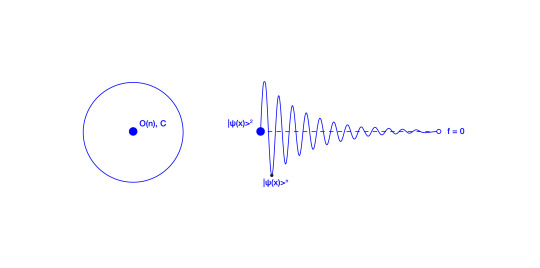
"Eternity isn’t some later time. Eternity isn’t even a long time. Eternity has nothing to do with time. Eternity is that dimension of here and now that all thinking in temporal terms cuts off." - J. Campbell
The wavefunction is defined here as a layer of the noumenal monad, a transition between epistemological and ontological, given by the limits of the Observer's senses and perception.
In this context, |ψ(x)>*n, with n not strictly equal to 2, transcends its conventional mathematical role within Hilbert space and diverges from standard quantum mechanics, suggesting that different values of n represent distinct dimensions or layers of noumenal collapse.
Each wavefunction is a layer of the noumenal lens, of which border is (n+), or consciousness C; it’s contents are negative noumena (n-) and it’s holographic centre “collapsed” onto a phenomenal Observer O(n) as function of noumenal self-reflection of consciousness.
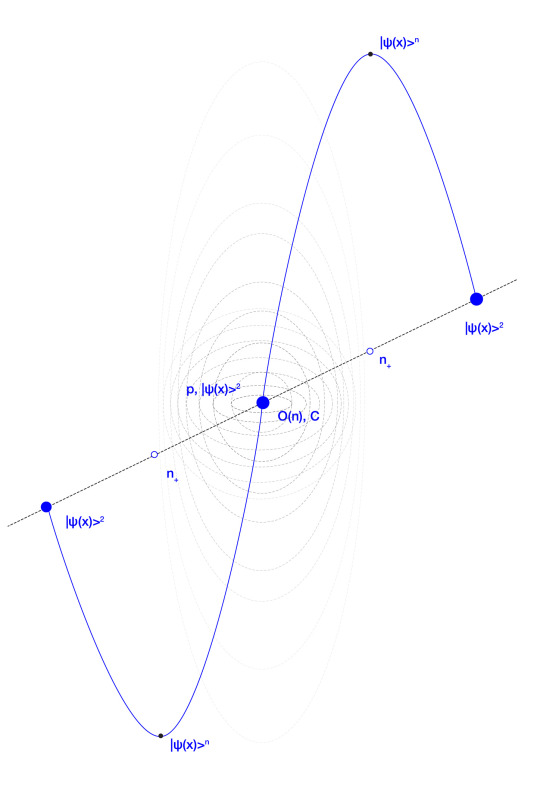
Furthermore, the Observer is envisioned as a holographic projection sitting at the core of the noumenal lens, emerging from the focus and diffraction of noumenal probabilities within the noumenal lens.
The perceptual border of positive noumena (n+) reflects and focuses noumenal probabilities (n-) into the hologram of the Observer O(n).

A rotation of noumenal lens reveals the noumenal essence (n+), hidden under the superposition of the noumenal lenses (n-) and the hologram of the Observer O(n).
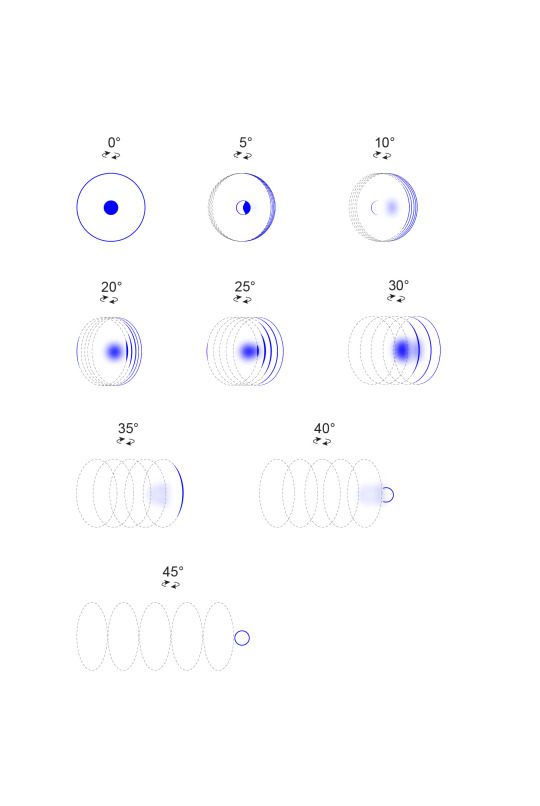
The observer’s perceptual focus, directed through Cognitive Gravity G and visualized with noumenal g(n) and cognitive gradients g(r), refracts the essence of Consciousness, transforming noumenal vertices into discernible edges like light through a prism.
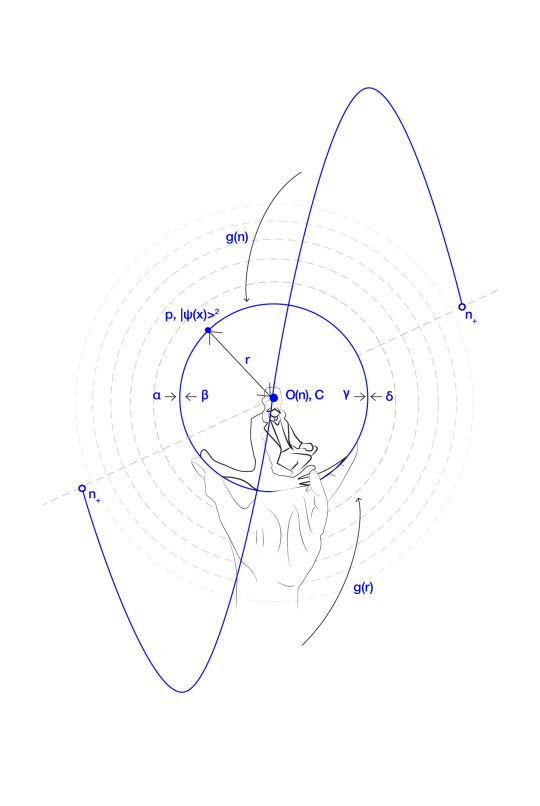
As the number of noumenal collapses increases, the complexity and breadth of the observer’s perceptual dimension diminishes, resulting in a progressive refinement and narrowing of perceptual prowess of the observable construct.
A cognitive threshold marks the evolution from a purely phenomenal observer to one with phantasiai and developed cognitive functions. This threshold varies according to the local conditions of the observer’s cognitive gradient and gravity and the overall noumenal function.
The hologram of a polynon enfolds within it the reflection of the noumenal substance, that both originates and reflects consciousness. It encapsulates the entirety of consciousness in each of its vertices and edges, as projections into a perceptual reality.
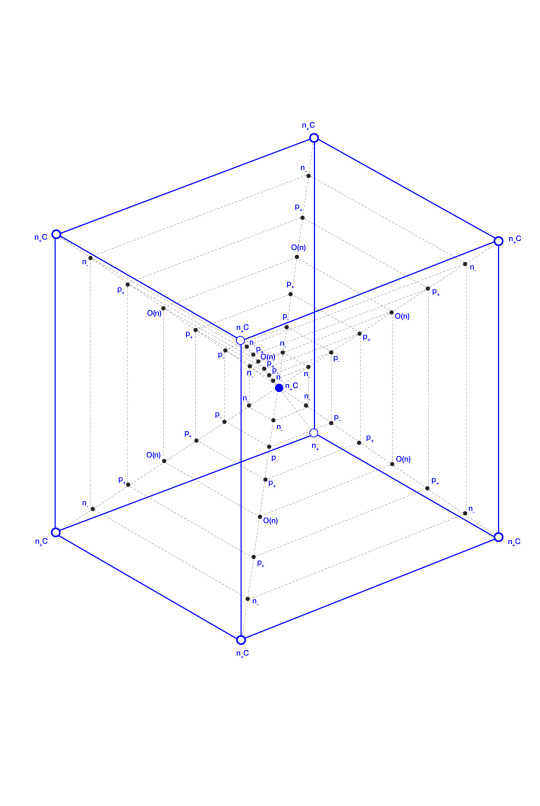
The concept of “consciousness nodes” describes (n+) zones between noumenal lenses (n−), revealed as vertices of the polynon, equal and identical in nature.
The Observer O(n) is in superposition with the phenomenal p+, epiphenomenal or phantasiai p-, negative noumena n- and noumenal vertices (and centre) n+ of the hexanon as a function for self-reflection of consciousness C.
The polynon is abstract and elusive, residing beyond human imagination yet within its grasp. No heavier than a fleeting idea, but far too heavy to be understood. A palindrome for language and thought, mirroring itself in perpetual paradox. Beginning the same way it ends.

From the "Polynon: A geometry of Consciousness", by Tib Roibu Read the paper here.
50 notes
·
View notes
Text
The nice thing about small talk and seemingly boring thoughts is that they help break up narratives on the way to more interesting thoughts.
55 notes
·
View notes